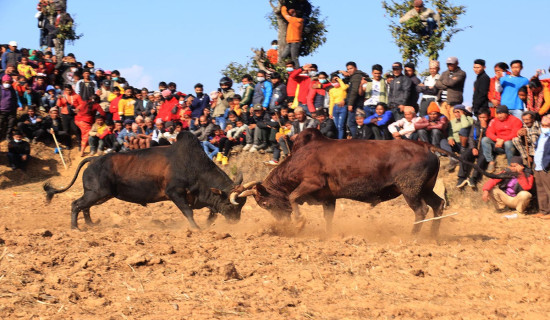- Friday, 16 January 2026
Saurya Airlines Crash
Take Stringent Steps For Air Safety
Yet another air tragedy occurred when a Saurya Airlines aircraft crashed on the premises of the Tribhuvan International Airport (TIA) in Kathmandu last Wednesday (July 24, 2024), in which 18 passengers lost their lives, with the captain of the doomed plane being the only survivor. This is the second passenger plane crash within 18 months, following one in Pokhara, where a Yeti Airlines plane crashed, resulting in 72 fatalities. Meanwhile, the Saurya aircraft accident ranks as the second biggest incident within the TIA grounds, following a US-Bangla airline plane crash in March 2018 that claimed the lives of 52 out of the 71 passengers on board. The deceased on the board of Bangladesh-based airlines included several Nepali students returning home after completing their MBBS and other courses in Bangladesh.
Both air accidents on the TIA premises that left several dead were a testimony of inadequate emergency and rescue responses inside the international airport, which is equipped with modern technology. The fire engines and rescue teams arrived late at the crash sites in both incidents, which allowed the fires to rapidly consume the planes. This resulted in the death of passengers who could have been saved if the fire had been extinguished promptly. Given the state of emergency responses at the international airport, one can only imagine the situation in hills and remote areas during air accidents.
Poor safety records
The crash of the Saurya plane, a Bombardier CRJ200 twin jet engine aircraft, is a tragic reminder of inadequate aviation safety in our country. It is clear from the fact that the European Union has prohibited Nepali planes from flying into European nations for the past 11 years, blaming the Nepali authorities for maintaining the poor safety records of their passenger aircraft and airline services. In response to a series of flight mishaps, European nations enforced the prohibition, resulting in the deaths of many European passengers, as well as Nepalis and others. Nepali authorities will have to wait even longer for the EU ban to be removed due to the new fatal crash.
On its way to Pokhara for a comprehensive examination, or C-Check, the ill-fated jet was undergoing a thorough inspection of its components, systems, and structures. Because the TIA has limited space and no hangar for conducting complete inspections for maintenance, Saurya Airlines was sending its aircraft, which had served for over 20 years, to Pokhara for an extensive examination for maintenance and repairs. The airline company was transporting its engineers and technicians to Pokhara on the same doomed aircraft. Except for one survivor, the plane’s captain, everyone on board perished, spurring several aviation experts in Nepal to question the airline operators’ decision to put so many technicians on an aircraft heading for maintenance work.
The fortunate pilot is expected to provide details about the disaster, after stating that he could not control the aircraft when it reached 100 metres above the runway after takeoff. According to some media reports, before its tragic end, the plane remained grounded in the TIA parking lot for a few days, where monsoon rain must have lashed it. This showed how inadequately the aircraft was maintained, casting doubt on the old plane’s airworthiness.
Meanwhile, aviation experts, the media, and some people pointed the blame at the country’s civil aviation authorities, which regulate airline services, airports, and other services for foreign airline operators. Many stated that the Civil Aviation Authority of Nepal (CAAN) did not enforce its rules for airline companies. Critics often point out that the Authority fails to address the flaws in airline carriers. Unfortunately, Pradip Adhikari, the CAAN Director General and Member Secretary, has an undesired record: as CAAN’s head, he has observed four tragic flight disasters. So far, he looks unconcerned and undisturbed by such tragic events.
Despite being the safest mode of travel, air travel lacks adequate safety maintenance and responses to address shortcomings in airline services in Nepal. The rough terrain of our country, meanwhile, presents significant obstacles for aviator. According to aviation experts, the country is one of the most challenging places to fly. Such challenges often induce pilots to make errors of judgement, resulting in disasters. As the country has several airports in mountainous areas, landing and taking off, as well as flying to and from these airports, are difficult.
As is customary, the government has appointed a committee to investigate the latest fatal crash of a Saurya aircraft. The committee is expected to produce findings and suggestions. The findings and reports appeared to be less effective in preventing air fatalities. Experts provide various pieces of advice for avoiding aviation accidents in our country. They suggest a diverse strategy is essential to address difficulties, and numerous modern techniques must prevent air tragedies. To enforce safety standards, aviation authorities must ensure stringent oversight and maintenance of aircraft in Nepal. CAAN should conduct regular audits and inspections and encourage airlines, pilots, and staff to prioritise safety above other considerations.
Emergency response
The government should improve airport infrastructure with the latest navigation and communication technology, as well as conduct frequent and comprehensive aircraft inspections to minimise mechanical failures, which are also essential to avoid similar catastrophes in Nepal’s skies. Detailed emergency response plans for prompt action in the event of an accident are required to save the lives of passengers and crew members.
Aviation industry professionals have provided the aforementioned tips to avoid disastrous air accidents that kill multiple passengers and crew, which would deal a blow to the Nepali aviation sector and bring a poor reputation to this sector across the globe. Therefore, the collaboration of the government, aviation authorities, airlines, and international organisations is crucial in implementing these suggestions to enhance air travel safety in Nepal.
(Upadhyay is a former managing editor of this daily.)
















